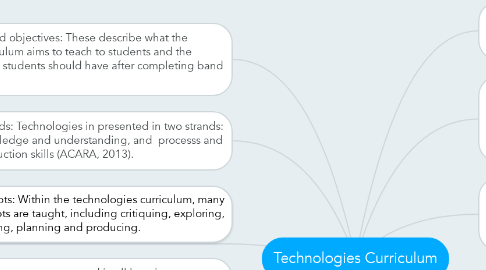Technologies Curriculum
by Nikki Panorios

1. Curriculum aims and objectives: These describe what the technologies curriculum aims to teach to students and the understanding that students should have after completing band levels.
2. Subjects: the two parts of the teachnolgies curriuculm are: design and technology, and digital technology.
3. Strands: Technologies in presented in two strands: knowledge and understanding, and processs and production skills (ACARA, 2013).
4. Key concepts: Within the technologies curriculum, many key concepts are taught, including critiquing, exploring, investigating, planning and producing.
5. Key ideas: The technologies learning area contains two key ideas, the first being systems thinking: creating preferred futures. This key idea allows students to think about how technology may evolve in the future and what impact this may have. The second key idea is project management, encompassing all aspects of project management, including ethical decision making (ACARA, 2013).
6. General capabilities: Skills that are encompassed in all learning areas, to connect curriculum. The seven general capabilities are: literacy, numeracy, ICT, critical and creative thinking, personal and social capabilities, ethical understandings and intercultural understandings.
7. Student diversity: Being committed to all school students, including students with a disability, gifted and talented students and students who speak English as a second language. Ensuring that the curriculum fits for all students.
8. Cross curriculum priorities: The three cross-curriculum priorities are: Aboriginal and Torres Straight Islander histories, Australia's engagement with Asia and sustainability. These should be intertwined into all learning areas and be taught throughout the curriculum.
9. Content descriptors: At each band level their are certain prescribed things that are expected to be taught by teachers and learnt by students, known as content descriptors.
10. Content elaborators: Content elaborators expand on the ideas of the content descriptors in greater detail. The are designed to," illustrate and exemplify what is to be taught" (ACARA, 2013).
11. Band levels: Each subject is written for and aimed at bands of year levels, known as band level descriptions. The bands are: foundation to year two, years three and four, years five and six, years seven and eight, and years nine and ten.
12. Achievement standards: Indicators to show the level of achievement of students and when they are ready to progress. The quality of the learning that is happening (ACARA, 2013).


